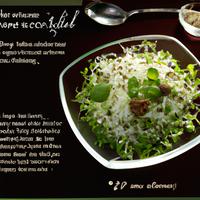
1 serving (50 grams) contains 16 calories, 1.3 grams of protein, 0.3 grams of fat, and 2.2 grams of carbohydrates.

Log this food in SnapCalorie

Nutrition Information
Calories |
76.2 | ||
|---|---|---|---|
% Daily Value* |
|||
| Total Fat | 1.7 g | 2% | |
| Saturated Fat | 0.2 g | 1% | |
| Polyunsaturated Fat | 0 g | ||
| Cholesterol | 0 mg | 0% | |
| Sodium | 33.3 mg | 1% | |
| Total Carbohydrates | 10.5 g | 3% | |
| Dietary Fiber | 2.6 g | 9% | |
| Sugars | 1.0 g | ||
| protein | 6.2 g | 12% | |
| Vitamin D | 0 mcg | 0% | |
| Calcium | 285.7 mg | 21% | |
| Iron | 3.1 mg | 17% | |
| Potassium | 1442.9 mg | 30% | |
* Percent Daily Values are based on a 2,000 calorie diet. Your daily values may be higher or lower depending on your calorie needs.
Food Attributes
Source of Calories
About Cress salad
Cress salad is a refreshing dish made primarily with cress, a nutrient-rich leafy green known for its peppery flavor. Commonly originating from European and Middle Eastern cuisines, cress is often blended with other fresh ingredients such as cucumber, radishes, and tomatoes, dressed lightly with olive oil, lemon juice, or a tangy vinaigrette. Packed with vitamins A, C, and K, as well as antioxidants, cress supports immune health, improves skin vitality, and promotes bone strength. Its fiber content aids digestion, while the naturally low calorie count makes it suitable for weight management. Olive oil in the dressing adds heart-healthy fats, although excessive use can raise calorie levels. When paired with lean proteins or quinoa, cress salad is a balanced, nourishing addition to meals, offering both flavor and health benefits.



